The Neighborhood Gardener: Five Invasive Plants to Know
Invasive exotic plants hurt ecosystems by displacing native plants and animals. Many, such as air potato, have been introduced as landscape plants and have gotten out of control. Get to know these five invasive plants and take action to control them.
Air Potato
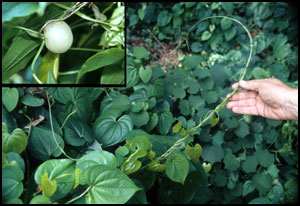 Click for larger image |
It is illegal to plant air potato, but the plant spreads quickly on its own. Air potato is a vigorously twining vine, which grows from an underground tuber. The stems can rapidly grow to 60 feet in length. The plant forms hundreds of bulbils, that drop to the ground and sprout more plants. Bulbils are round and light brown, with small nubs on them, and can range from the size of a pea to five inches across. Air potato leaves are heart-shaped and can be up to eight inches long. One of the most important control measures for air potato is the removal of bulbils and tubers.
Chinese Tallow
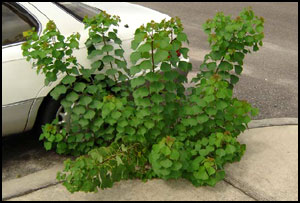 Click for larger image |
Chinese tallow is an invasive exotic plant that grows and spreads rapidly, and has taken over large areas of the southeast U.S. Until it was recently prohibited by state law, this small tree was planted as an ornamental in Florida, making it still very common in yards. The leaves are heart-shaped and turn vibrant red in the fall. The seeds, which also appear in autumn, give the plant the nickname "popcorn tree." Birds eat the seeds and their droppings spread the tallow to other landscapes and natural areas. Seeds can also be carried to new sites by water. Floridians can help slow the further spread of Chinese tallow by removing these hard-to-kill trees from their properties. After cutting down the trees, treat the stumps with herbicide to prevent re-sprouting.
Melaleuca
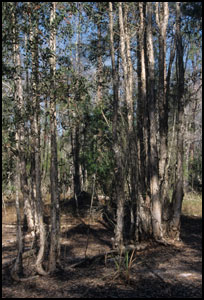 Click for larger image |
Melaleuca is a highly invasive tree choking the Everglades and other areas of South Florida. Melaleuca trees were brought to the United States from Australia in the late 1800s. In Florida, this plant quickly invaded natural areas. Melaleuca forms dense stands which completely transform natural habitats. The trees displace native plant communities and wildlife, including some endangered species; disturb water flow; and alter soil conditions. State, federal, and regional agencies are all teaming up to battle this invasive exotic. The USDA is heading an effort called TAME Melaleuca, which educates the public about the tree and its effects. Homeowners can help by removing any melaleuca they find in their landscapes.
Brazilian Pepper
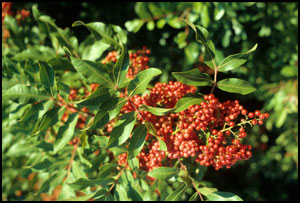 Click for larger image |
The Brazilian pepper-tree is one of Florida's most aggressive invasive exotic pest plants. It produces a dense canopy that shades out most other plants and this monoculture provides poor habitat for native animals and plants. This tree or shrub also invades wetland habitats, reducing the quality of wetlands. Brazilian pepper-trees should be removed if found in a landscape. Avoid touching the leaves and sap as a rash can result. Some people are also very sensitive to touching only the leaves. This plant can be effectively controlled by cutting and treating the stumps with herbicide. The trunk should be cut as close to the ground as possible. Within five minutes, a recommended herbicide should be carefully applied to the entire stump.
Old World Climbing Fern
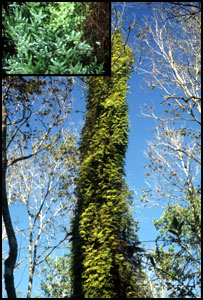 Click for larger image |
Parts of Florida are under attack, not by an army of soldiers but by invasive plants like the Old World climbing fern, which has taken control of 100,000 acres in Florida. Old World climbing fern has wiry fronds that twine their way to the tops of trees, smothering entire sections of forest. It can also make wildfires much worse by acting as a conduit for the flames. This plant can be treated with herbicides, but eradication is especially difficult in isolated areas. In 2005, a special moth was released in southeast Florida as the first biocontrol agent, though it may be several years or decades before the insect's effects are known. Be part of the solution: learn to identify and control this rapidly growing invasive exotic.




